
7 семестр (Бормотов А) / 1man_bw_l23_30_chn_23_30_instruktsiya_po_ekspluatatsii / MAN-BW L23-30 (ЧН 225_300)+ / MAN-BW L23-30h project-guide
.pdf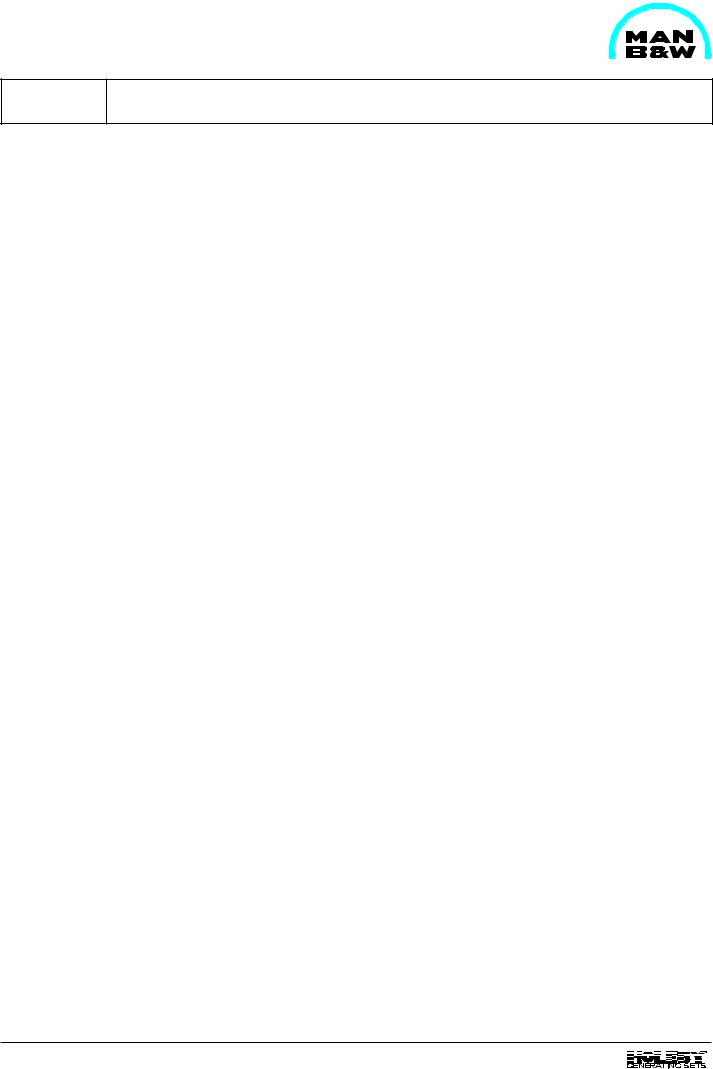
1607591-7.3 Page 1 (1)
Moment of Inertia |
D 10 30 0 |
|
|
L23/30H
No. of |
Generator |
Max. cont. |
Speed |
|
Moment of inertia (J) |
|
||
|
|
|
|
|||||
|
|
|
|
|||||
|
|
|
rating |
|
Engine |
Flywheel |
Generator |
Total |
cyl. |
type |
kW |
r/min. |
|
|
*** |
|
|
|
|
|
|
|
kgm2 |
kgm2 |
kgm2 |
kgm2 |
|
|
DIDBN* |
650 |
720 |
51.1 |
273.5 |
95.0 |
419.6 |
|
|
121h/10 |
||||||
|
|
|
|
|
|
|
|
|
|
|
|
|
|
|
|
|
|
5 |
|
DIDBN* |
675 |
750 |
51.1 |
273.5 |
84.0 |
408.6 |
|
121h/8 |
|||||||
|
|
|
|
|
|
|
|
|
|
|
|
|
|
|
|
|
|
|
|
LSA** |
800 |
900 |
58.9 |
273.5 |
69.3 |
401.7 |
|
|
52B M7/8p |
||||||
|
|
|
|
|
|
|
|
|
|
|
|
|
|
|
|
|
|
|
|
DIDBN* |
780 |
720 |
37.4 |
273.5 |
132.0 |
442.9 |
|
|
121k/10 |
||||||
|
|
|
|
|
|
|
|
|
|
|
|
|
|
|
|
|
|
6 |
|
DIDBN* |
810 |
750 |
37.4 |
273.5 |
94.0 |
404.9 |
|
121i/8 |
|||||||
|
|
|
|
|
|
|
|
|
|
|
|
|
|
|
|
|
|
|
|
LSA** |
960 |
900 |
65.5 |
273.5 |
83.0 |
422.0 |
|
|
52B L9/8p |
||||||
|
|
|
|
|
|
|
|
|
|
|
|
|
|
|
|
|
|
|
|
DIDBN* |
910 |
720 |
61.4 |
100.0 |
170.0 |
331.4 |
|
|
131h/10 |
||||||
|
|
|
|
|
|
|
|
|
|
|
|
|
|
|
|
|
|
7 |
|
DIDBN* |
945 |
750 |
61.4 |
100.0 |
110.0 |
271.4 |
|
121k/8 |
|||||||
|
|
|
|
|
|
|
|
|
|
|
|
|
|
|
|
|
|
|
|
LSA** |
1120 |
900 |
47.9 |
111.3 |
120.0 |
279.2 |
|
|
54 VS4/8p |
||||||
|
|
|
|
|
|
|
|
|
|
|
|
|
|
|
|
|
|
|
|
DIDBN* |
1040 |
720 |
49.6 |
100.0 |
200.0 |
349.6 |
|
|
131i/10 |
||||||
|
|
|
|
|
|
|
|
|
|
|
|
|
|
|
|
|
|
8 |
|
DIDBN* |
1080 |
750 |
49.6 |
100 |
152.0 |
301.6 |
|
131h/8 |
|||||||
|
|
|
|
|
|
|
|
|
|
|
|
|
|
|
|
|
|
|
|
LSA** |
1280 |
900 |
78.5 |
273.5 |
133.3 |
485.3 |
|
|
54 VS5/8p |
||||||
|
|
|
|
|
|
|
|
|
|
|
|
|
|
|
|
|
|
*Generator, make A. van Kaick
**Generator, make Leroý Somer
***If other generator is chosen the values will change.
Moment of inertia : |
GD2 = J x 4 (kgm2) |
92.23
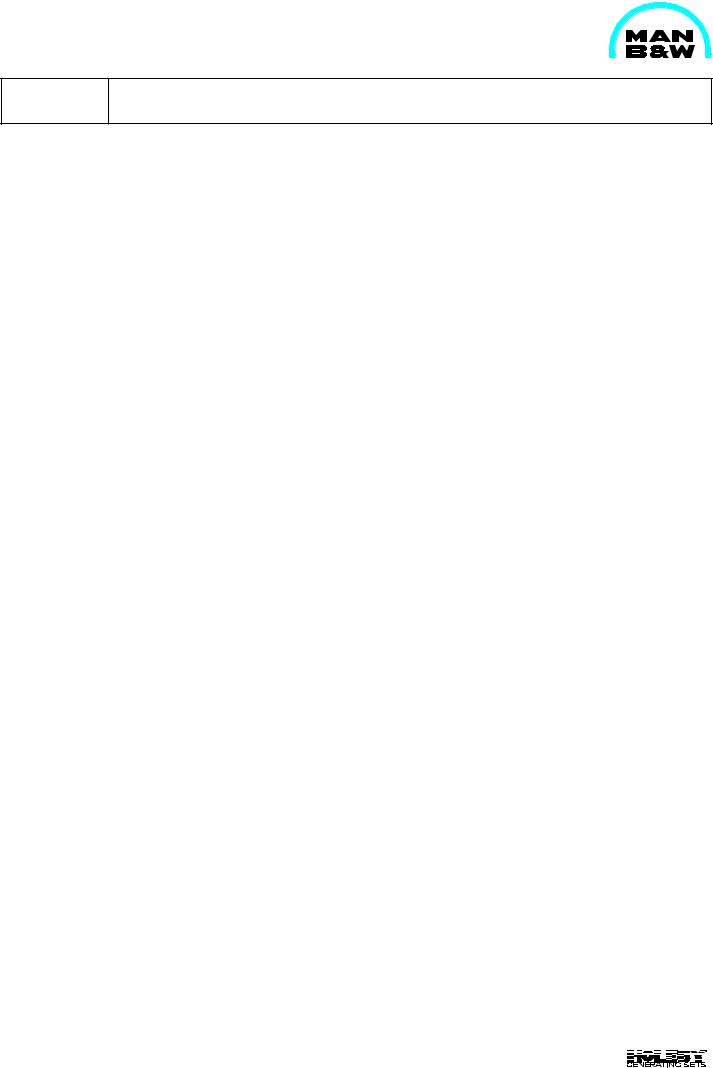
1607531-9.4 Page 1 (2)
Overhaul Recommendations |
D 10 35 0 |
|
|
|
|
|
|
L23/30H |
|
|
|
|
|
|
|
|
Component |
|
Hours |
Expected |
|
|
Overhaul Recommendations for 720/750 RPM |
Between |
Service |
|
|
|
|
|
Overhauls |
Life |
|
|
Turbocharger |
Dry cleaning of turbine side ............................................................. |
every second |
|
|
|
|
or |
day |
|
|
|
|
Wet cleaning of turbine side ............................................................ |
every week |
|
|
|
|
Water washing of compressor side ................................................. |
25-75 |
|
|
|
|
Air filter cleaning : Based on observations. |
with new or |
|
|
|
|
Inspection: Check all mounting screws, casing screws and pipe |
|
|
|
|
|
overhauled |
|
|
|
|
|
line connections for tight fit by tapping, retighten if necessary ......... |
turbocharger |
|
|
|
|
Compressor cleaning in dismantled condition: compressor |
once aft 1000 |
|
|
|
|
|
|
|
|
|
|
inner components, final diffusor, compressor wheel ........................ |
6-8.000 |
|
|
|
|
Silencer cleaning in dismantled condition: silencer felt linings ... |
6-8.000 |
|
|
|
|
Major overhaul: Dismantling, cleaning, inspection, checking and |
|
|
|
|
|
cleaning cartridge, checking bearing clearances, checking gaps |
|
|
|
|
|
and clearances on reassembly ....................................................... |
16.000 |
|
|
|
Regulating system |
Function check of overspeed and shutdown devices. |
|
|
|
|
|
Check that the control rod of each individual fuel pump can easily |
|
|
|
|
|
go to "stop" position ......................................................................... |
monthly |
|
|
|
Cylinder head |
Checking and adjustment of valve clearance .................................. |
2.000 |
|
|
|
Fuel injection valve |
Checking, cleaning and adjustment of opening pressure ................ |
2.000 |
|
|
|
Exhaust valve |
Overhaul and regrinding of spindle and valve seat .......................... |
16.000 |
32.000 |
|
|
|
Function check of rotocap ............................................................... |
monthly |
|
|
|
Air inlet valve |
Overhaul in connection with exhaust valve overhaul ....................... |
16.000 |
32.000 |
|
|
Valve guide |
Measuring of inside diameter in connection with valve overhaul ..... |
16.000 |
32.000 |
|
|
Cylinder head nuts |
Retightening 200 hours after new or overhaul |
|
|
|
|
Compressed air system |
Check of compressed air system .................................................... |
16.000 |
|
|
|
|
Refill of air lubricator : Based on observations. |
|
|
|
|
Main bearings |
Inspection according to classification survey, normally after 24.000 |
|
|
|
|
|
running hours or 4 years of service ................................................. |
16.000 |
48.000 |
|
|
|
Retightening of main bearing cap. 200 hours after new or overhaul |
6-8.000 |
|
|
|
|
and every ........................................................................................ |
|
|
|
|
|
Retightening of screws for counterweights. 200 hours after new or |
|
|
|
|
|
overhaul and every .......................................................................... |
6-8.000 |
|
|
|
Supporting chocks |
Retightening of holding-down bolts. 200 á 1000 hours after new or |
|
|
|
|
and bolt connections |
overhaul and every .......................................................................... |
6-8.000 |
|
|
|
|
Retightening of bolts between engine frame and base frame .......... |
6-8.000 |
|
|
|
|
For flexible mounted engines. Check anti-vibration mountings ........ |
6-8.000 |
|
|
|
Autolog reading |
Crankshaft deflection and main bearing clearance reading. Should |
|
|
|
|
|
be carried out in connection with retightening of main bearing and |
|
|
|
|
|
holding-down bolts .......................................................................... |
6-8.000 |
|
|
|
Big-end bearing |
Retightening and checking of bearing clearance. 200 hours after |
|
|
|
|
|
new or overhaul and every .............................................................. |
6-8.000 |
|
|
|
|
Inspection in connection with piston overhaul ................................. |
16.000 |
32.000 |
|
|
Piston |
Overhaul, replacement of compression rings and scraper rings, |
|
|
|
|
|
measuring of ring grooves, inspection of big-end bearing and |
|
|
|
|
|
inspection of cylinder liner condition ................................................ |
16.000 |
64.000 |
|
|
Cylinder liner |
Inspection, measuring and reconditioning of running surface |
|
|
|
|
|
condition: In connection with piston overhaul .................................. |
16.000 |
80.000 |
|
|
|
Overhaul and reconditioning of surface between liner and frame and |
|
|
|
|
|
cleaning of surface in cooling water space ...................................... |
32.000 |
|
|
|
Fuel pump |
Fuel pump barrel/plunger assembly. Overhaul based on operational |
|
|
|
|
|
observations .................................................................................... |
|
32.000 |
|
|
Torsional vibration |
Overhaul ......................................................................................... |
32.000 |
|
|
|
dampers |
A sample of silicone fluid must be taken and analysed in between. |
|
|
|
|
Lub. oil filter cartr. |
Replacement based on observations of pressure drop ................... |
|
1.500 |
|
|
Filter Cartridges |
Replacement based on observations .............................................. |
|
1.500 |
|
|
|
|
|
|
|
|
|
|
|
|
|
92.41
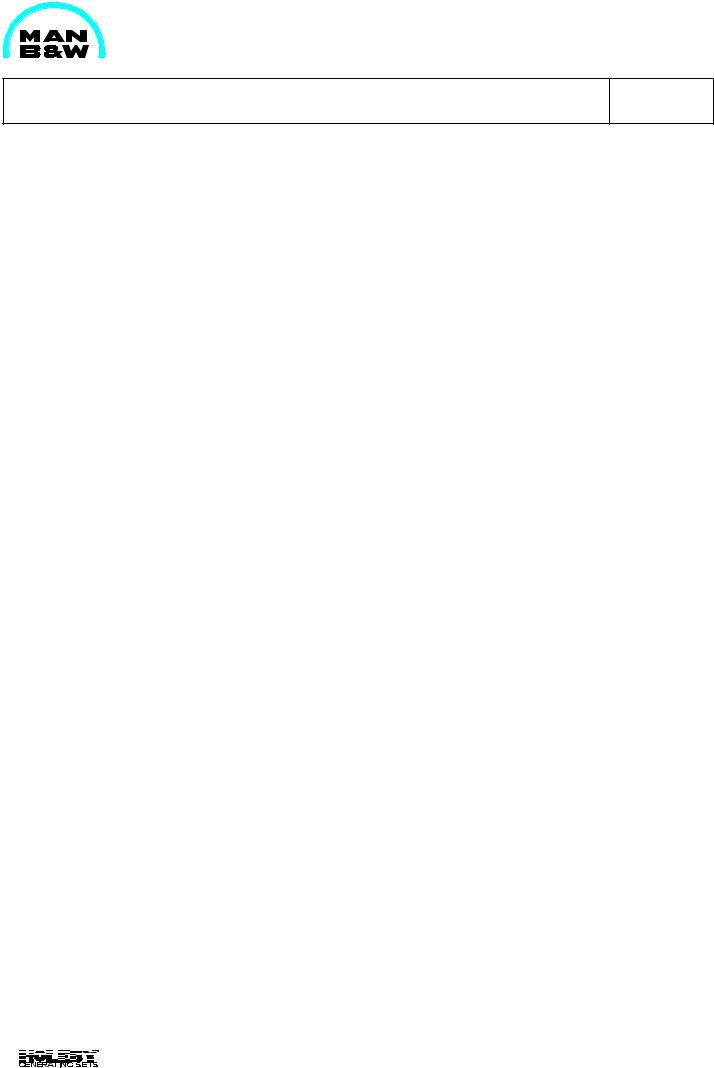
D 10 35 0 |
Overhaul Recommendations |
|
|
1607531-9.4 Page 2 (2)
L23/30H
|
|
|
Hours |
Expected |
|
|
Component |
Overhaul Recommendations for 900 RPM |
Between |
Service |
|
|
|
|
Overhauls |
Life |
|
|
Turbocharger |
Dry cleaning of turbine side ............................................................. |
every second |
|
|
|
|
or |
day |
|
|
|
|
Wet cleaning of turbine side ............................................................ |
every week |
|
|
|
|
Water washing of compressor side ................................................. |
25-75 |
|
|
|
|
Air filter cleaning : Based on observations. |
with new or |
|
|
|
|
Inspection: Check all mounting screws, casing screws and pipe |
|
|
|
|
|
overhauled |
|
|
|
|
|
line connections for tight fit by tapping, retighten if necessary ......... |
turbocharger |
|
|
|
|
Compressor cleaning in dismantled condition: compressor |
once aft 1000 |
|
|
|
|
6.000 |
|
|
|
|
|
inner components, final diffusor, compressor wheel ........................ |
|
|
|
|
|
Silencer cleaning in dismantled condition: silencer felt linings ... |
6.000 |
|
|
|
|
Major overhaul: Dismantling, cleaning, inspection, checking and |
|
|
|
|
|
cleaning cartridge, checking bearing clearances, checking gaps |
12.000 |
|
|
|
|
and clearances on reassembly ....................................................... |
|
|
|
|
Regulating system |
Function check of overspeed and shutdown devices. |
|
|
|
|
|
Check that the control rod of each individual fuel pump can easily |
monthly |
|
|
|
|
go to "stop" position ......................................................................... |
|
|
|
|
Cylinder head |
Checking and adjustment of valve clearance .................................. |
2.000 |
|
|
|
Fuel injection valve |
Checking, cleaning and adjustment of opening pressure ................ |
2.000 |
|
|
|
Exhaust valve |
Overhaul and regrinding of spindle and valve seat .......................... |
12.000 |
24.000 |
|
|
|
Function check of rotocap ............................................................... |
monthly |
|
|
|
Air inlet valve |
Overhaul in connection with exhaust valve overhaul ....................... |
12.000 |
24.000 |
|
|
Valve guide |
Measuring of inside diameter in connection with valve overhaul ..... |
12.000 |
24.000 |
|
|
Cylinder head nuts |
Retightening 200 hours after new or overhaul |
|
|
|
|
Compressed air system |
Check of compressed air system .................................................... |
12.000 |
|
|
|
|
Refill of air lubricator : Based on observations. |
|
|
|
|
Main bearings |
Inspection according to classification survey, normally after 24.000 |
24.000 |
36.000 |
|
|
|
running hours or 4 years of service ................................................. |
|
||
|
|
Retightening of main bearing cap. 200 hours after new or overhaul |
6.000 |
|
|
|
|
and every ........................................................................................ |
|
|
|
|
|
Retightening of screws for counterweights. 200 hours after new or |
6.000 |
|
|
|
|
overhaul and every .......................................................................... |
|
|
|
|
Supporting chocks |
Retightening of holding-down bolts. 200 á 1000 hours after new or |
|
|
|
|
and bolt connections |
overhaul and every .......................................................................... |
6.000 |
|
|
|
|
Retightening of bolts between engine frame and base frame .......... |
6.000 |
|
|
|
|
For flexible mounted engines. Check anti-vibration mountings ........ |
6.000 |
|
|
|
Autolog reading |
Crankshaft deflection and main bearing clearance reading. Should |
|
|
|
|
|
be carried out in connection with retightening of main bearing and |
6.000 |
|
|
|
|
holding-down bolts .......................................................................... |
|
|
|
|
Big-end bearing |
Retightening and checking of bearing clearance. 200 hours after |
6.000 |
|
|
|
|
new or overhaul and every .............................................................. |
|
|
|
|
|
Inspection in connection with piston overhaul ................................. |
12.000 |
24.000 |
|
|
Piston |
Overhaul, replacement of compression rings and scraper rings, |
|
|
|
|
|
measuring of ring grooves, inspection of big-end bearing and |
12.000 |
60.000 |
|
|
|
inspection of cylinder liner condition ................................................ |
|
||
|
Cylinder liner |
Inspection, measuring and reconditioning of running surface |
12.000 |
60.000 |
|
|
|
condition: In connection with piston overhaul .................................. |
|
||
|
|
Overhaul and reconditioning of surface between liner and frame and |
24.000 |
|
|
|
|
cleaning of surface in cooling water space ...................................... |
|
|
|
|
Fuel pump |
Fuel pump barrel/plunger assembly. Overhaul based on operational |
|
30.000 |
|
|
|
observations .................................................................................... |
|
|
|
|
Torsional vibration |
Overhaul ......................................................................................... |
30.000 |
|
|
|
dampers |
A sample of silicone fluid must be taken and analysed in between. |
|
|
|
|
Lub. oil filter cartr. |
Replacement based on observations of pressure drop ................... |
|
1.500 |
|
|
Filter cartrigdes |
Replacement based on observations .............................................. |
|
1.500 |
|
|
|
|
|
|
|
|
|
|
|
|
|
92.41

Basic Diesel Engine
B 10
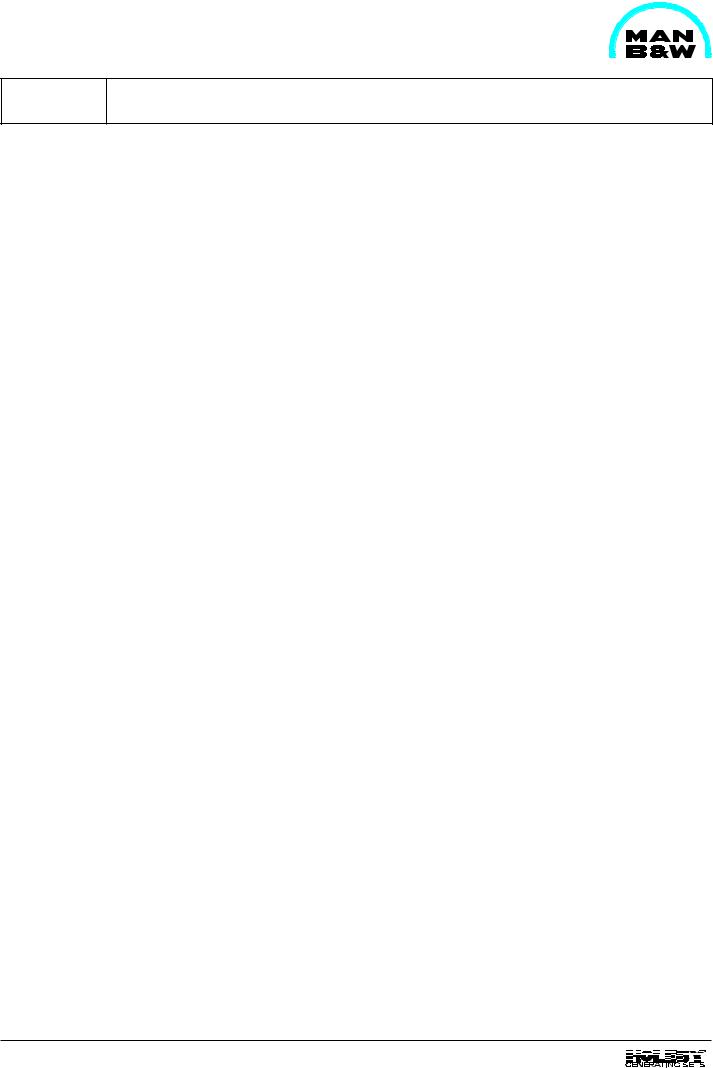
1613472-6.6 Page 1 (5)
General Description |
B 10 01 1 |
|
|
L23/30H
General |
Cylinder Liner |
The engine is a turbocharged, single-acting, fourstroke diesel engine of the trunk piston type with a cylinder bore of 225 mm and a stroke of 300 mm, the crankshaft speed are 720, 750 or 900 rpm.
The engine can be delivered as an in-line engine with 5 to 8 cylinders.
Engine Frame
The engine frame which is made of cast iron is a monobloc design incorporating the cylinder bloc, the crankcase and the supporting flanges.
The charge air receiver, the cooling water jackets and the housing for the camshaft and drive are also integral parts of this one-piece casting.
The main bearings for the underslung crankshaft are carried in heavy supports in the frame plating and are secured by bearing caps. To ensure strong and sturdy bedding of the caps, these are provided with side guides and held in place by means of studs with hydraulically tightened nuts. The main bearings are equipped with replaceable shells which are fitted without scraping.
The crankshaft guide bearing is located at the flywheel end of the engine.
On the sides of the frame there are covers for access to the camshaft, the charge air receiver and crankcase. Some of the covers are fitted with relief valves which will act, if oil vapours in the crankcase should be ignited, for instance in the event of a hot bearing.
Base Frame
The engine and alternator are mounted on a common base frame. The rigid base frame construction can be embedded directly on the engine seating or flexible mounted.
The engine part of the base frame acts as lubricating oil reservoir.
The cylinder liner is made of fine grained, pearlite cast iron and fitted in a bore in the engine frame. The liner is clamped by the cylinder head and is guided by a bore at the bottom of the cooling water space of the engine frame. The liner can thus expand freely downwards when heated during the running of the engine. Sealing for the cooling water is obtained by means of rubber rings which are fitted in grooves machined in the liner.
Cooling water is supplied at the bottom of the cooling water space between the liner and the engine frame and leaves through bores in the top of the frame to the cooling water jacket.
Cylinder Head
The cylinder head is of cast iron, made in one piece. It has a central bore for the fuel injection valve and bores for two exhaust valves, two inlet valves, indicator valve and cooling water.
The cylinder head is tightened by means of 4 nuts and 4 studs, which are screwed into the engine frame. The nuts are tightened by means of hydraulic jacks.
The cylinder head has a screwed-on coaming which encloses the valves. The coaming is closed with a top cover and thus provides an oil tight enclosure for the valve gear.
Air Inlet and Exhaust Valves.
The inlet and exhaust valve spindles are identical and therefore interchangeable.
The valve spindles are made of heat-resistant material and the spindle seats are armoured with welded-on hard metal.
All valve spindles are fitted with valve rotators which turn the spindles each time the valves are activated. The turning of the spindles is ensuring even temperature levels on the valve discs and prevents deposits on the seating surfaces.
96.12
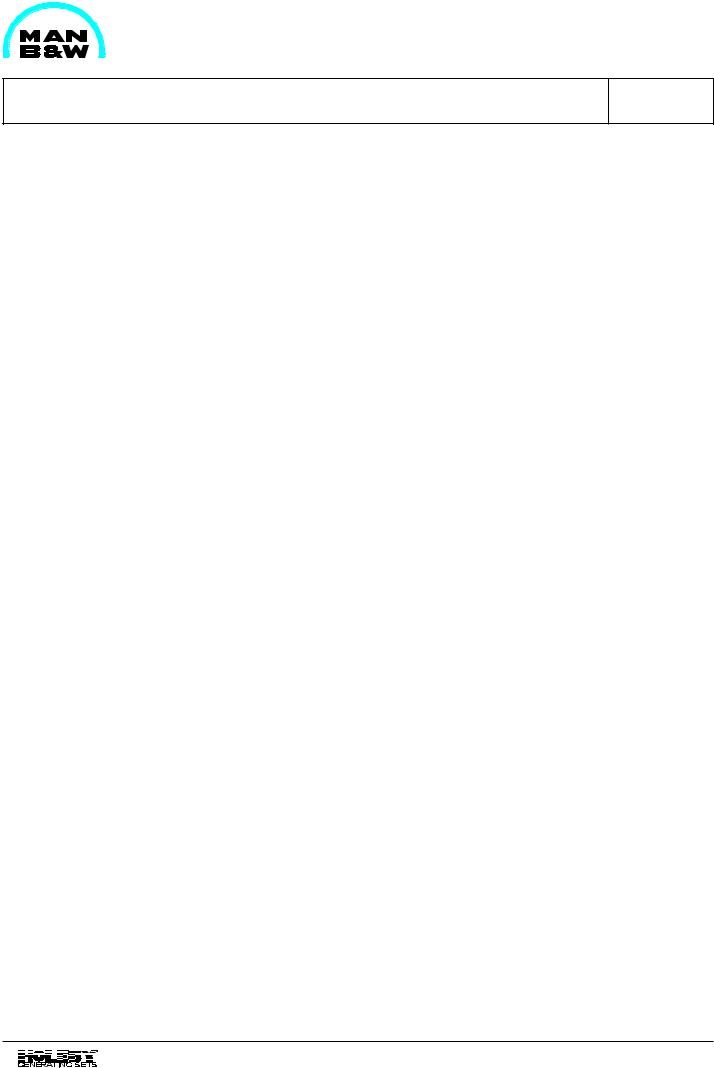
B 10 01 1 |
General Description |
|
|
L23/30H
1613472-6.6 Page 2 (5)
The cylinder head is equipped with replaceable valve seat rings, which are directly water cooled in order to assure low valve temperatures.
The seat rings are made of heat-resistant steel. The seting surfaces are hardened in order to minimize wear and prevent dent marks, on the inlet seat by induction hardening, on the exhaust seat by hard metal armouring.
Valve Actuating Gear
The rocker arms are actuated through rollers, roller guides and push rods. The roller guide for fuel pump and for inlet and exhaust valves are mounted in one common housing for each cylinder. This housing is bolted to the engine frame.
Each rocker arm activates two spindles through a spring-loaded valve bridge with thrust screws and adjusting screws for valve clearance.
The valve actuating gear is pressure-feed lubricated from the centralized lubricating system of the engine. A non-return valve blocks the oil inlet to the rocker arms during prelubricating.
Fuel Injection System
The engine is provided with one fuel injection pump, an injection valve, and a high pressure pipe for each cylinder.
The injection pump is mounted on the valve gear housing by means of two screws. The pump consists of a pump housing, a centrally placed pump barrel and a plunger. The pump is activated by the fuel cam, and the volume injected is controlled by turning the plunger.
The fuel injection valve is located in a valve sleeve in the center of the cylinder head. The opening of the valve is controlled by the fuel oil pressure, and the valve is closed by a spring.
The high pressure pipe which is led through a bore in the cylinder head is surrounded by a shielding tube.
The shielding tube has two holes in order to ensure that any leakage will be drained off to the cylinder head bore. The bore is equipped with drain channel and pipe.
The complete injection equipment inclusive injection pumps, high pressure and low pressure pipes is well enclosed behind removable covers.
Piston
The piston, which is oil-cooled and of the monobloc type made of nodular cast-iron, is equipped with 3 compression rings and 1 oil scraper ring.
By the use of compression rings with different barrelshaped profiles and chrome-plated running surfaces, the piston ring pack is optimized for maximum sealing effect and minimum wear rate.
The piston has a cooling oil space close to the piston crown and the piston ring zone. The heat transfer and thus the cooling effect is based on the shaker effect arising during the piston movement. The cooling medium is oil from the engine's lubricating oil system.
Oil is supplied to the cooling oil space through channels from the oil grooves in the piston pin bosses. Oil is drained from the cooling oil space through ducts situated diametrically to the inlet channels.
The piston pin is fully floating and kept in position in axial direction by two circlips (seeger rings). The piston pin is equipped with channels and holes for supply of oil to lubrication of the pin bosses and for supply of cooling oil to the piston.
Connecting Rod
The connecting rod is die-forged. The big-end has an inclined joint in order to facilitate the piston and connecting rod assembly to be withdrawn up through the cylinder liner. The joint faces on connecting rod and bearing cap are serrated to ensure precise location and to prevent relative movement of the parts.
96.12
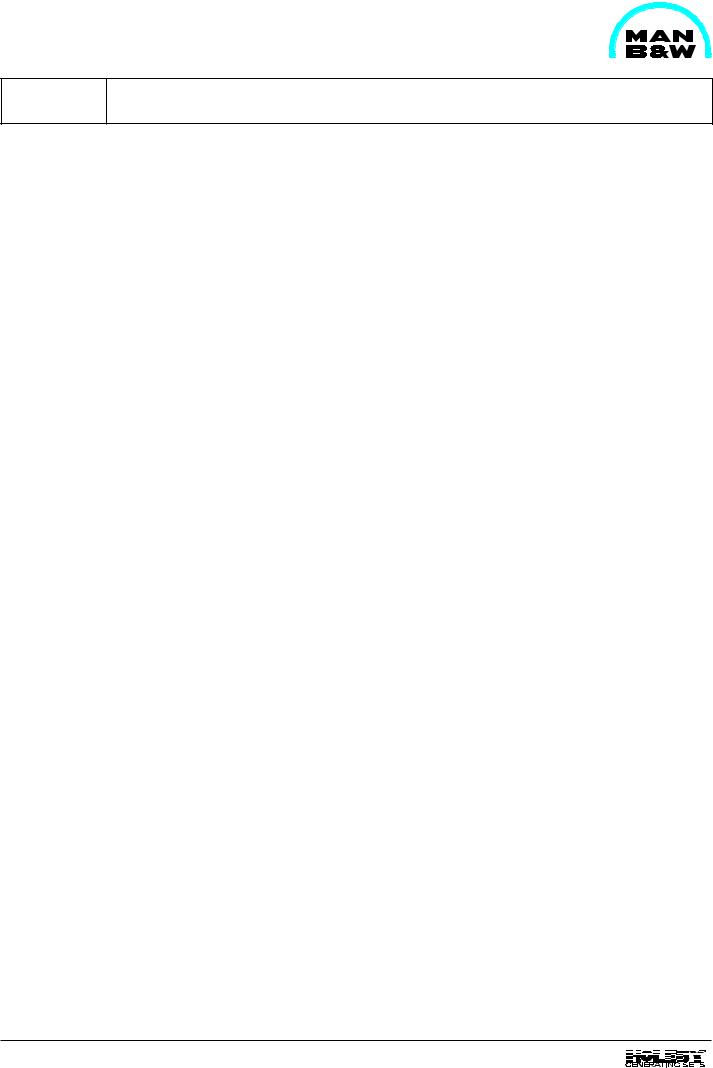
1613472-6.6 Page 3 (5)
General Description |
B 10 01 1 |
|
|
L23/30H
The connecting rod has bored channels for supply of oil from the big-end to the small-end.
The big-end bearing is of the trimetal type coated with a running layer.
The bearing shells are of the precision type and are therefore to be fitted without scraping or any other kind of adaption.
The small-end bearing is of trimetal type and is pressed into the connecting rod. The bush is equipped with an inner circumferential groove, and a pocket for distribution of oil in the bush itself and for supply of oil to the pin bosses.
Crankshaft and Main Bearings
The crankshaft, which is a one-piece forging, is suspended in underslung bearings. The main bearings are of the trimetal type, which are coated with a running layer. To attain a suitable bearing pressure and vibration level the crankshaft is provided with counterweights, which are attached to the crankshaft by means of two screws.
At the flywheel end the crankshaft is fitted with a gear wheel which through an intermediate wheel drives the camshaft.
Also fitted here is a coupling flange for connection of a generator. At the opposite end (front end) there is a claw-type coupling for the lub. oil pump or a flexible gear wheel connection for lub. oil and water pumps.
Lubricating oil for the main bearings is supplied through holes drilled in the engine frame. From the main bearings the oil passes through bores in the crankshaft to the big-end bearings and hence through channels in the connecting rods to lubricate the piston pins and cool the pistons.
Camshaft and Camshaft Drive
The inlet and exhaust valves as well as the fuel pumps of the engine are actuated by a camshaft.
The camshaft is placed in the engine frame at the control side (left side, seen from the flywheel end).
The camshaft is driven by a gear wheel on the crankshaft through an intermediate wheel, and rotates of a speed which is half of that of the crankshaft.
The camshaft is located in bearing bushes which are fitted in bores in the engine frame, each bearing is replaceable and locked in position in the engine frame by means of a locking screw.
A guidering mounted at the flywheel end guides the camshaft in the longitudinal direction.
Each section is equipped with fixed cams for operation of fuel pump, air inlet valve and exhaust valve.
The foremost section is equipped with a splined shaft coupling for driving the fuel oil feed pump (if mounted). The gear wheel for driving the camshaft as well as a gear wheel connection for the governor drive are screwed on to the aftmost section.
The lubricating oil pipes for the gear wheels are e- quipped with nozzles which are adjusted to apply the oil at the points where the gear wheels are in mesh.
Governor
The engine speed is controlled by a hydraulic or electric governor.
Monitoring and Control System
All media systems are equipped with thermometers and manometers for local reading and for the most essential pressures the manometers are together with tachometers centralized in an engine-mounted instruments panel.
The number of and type of parameters to have alarm function are chosen in accordance with the requirements from the classification societies.
The engine has as standard shut-down functions for lubricating oil pressure low, cooling water temperature high and for overspeed.
96.12
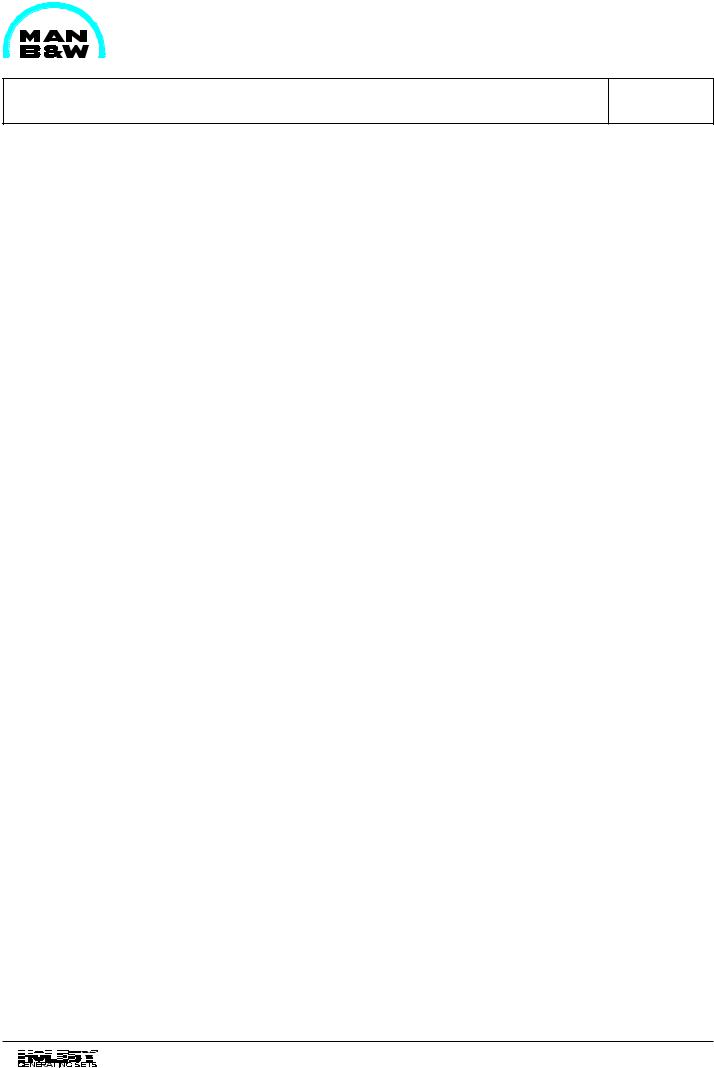
B 10 01 1 |
General Description |
|
|
L23/30H
1613472-6.6 Page 4 (5)
Turbocharger System
The turbocharger system of the engine, which is a constant pressure system, consists of an exhaust gas receiver, a turbocharger, a charging air cooler and a charging air receiver, the latter being intergrated in the engine frame.
The turbine wheel of the turbocharger is driven by the engine exhaust gas, and the turbine wheel drives the turbocharger compressor, which is mounted on the common shaft. The compressor draws air from the engine room, through the air filters.
The turbocharger presses the air through the charging air cooler to the charging air receiver. From the charging air receiver, the air flows to each cylinder, through the inlet valves.
The charging air cooler is a compact tube-type cooler with a large cooling surface. The cooling water is passed twice through the cooler, the end covers being designed with partitions which cause the cooling water to turn.
The cooling water tubes are fixed to the tube plates by expansion.
From the exhaust valves, the exhaust is led through a water cooled intermediate piece to the exhaust gas receiver where the pulsatory pressure from the individual exhaust valves is equalized and passed to the turbocharger as a constant pressure, and further to the exhaust outlet and silencer arrangement.
The exhaust gas receiver is made of pipe sections, one for each cylinder, connected to each other, by means of compensators, to prevent excessive stress in the pipes due to heat expansion.
In the cooled intermediate piece a thermometer for reading the exhaust gas temperature is fitted and there is also possibility of fitting a sensor for remote reading.
To avoid excessive thermal loss and to ensure a reasonably low surface temperature the exhaust gas receiver is insulated.
Compressed Air System
The engine is started by means of a built-on air starter.
The compressed air system comprises a main starting valve, an air strainer, a remote controlled starting valve and an emergency starting valve which will make it possible to start the engine in case of a power failure.
Fuel Oil System
The built-on fuel oil system consists of the fuel oil filter and the fuel injection system. An engine-driven fuel oil feed pump can be mounted as optional.
The fuel oil feed pump, which is of the gear pump type, is mounted to the front end of the engine frame and driven by the camshaft through a splined shaft coupling, the pump housing is equipped with a spring-loaded adjustable by-pass valve.
The fuel oil filter is a duplex filter. The filter is equipped with a three-way cock for single or double operation of the filters.
Waste oil and fuel oil leakage is led to a leakage alarm which is heated by means of fuel return oil.
Lubricating Oil System
All moving parts of the engine are lubricated with oil circulating under pressure.
The lubricating oil pump is of the gear wheel type with built-in pressure control valve. The pump draws the oil from the sump in the base frame, and on the pressure side the oil passes through the lubricating oil cooler and the filter which both are mounted on the engine.
Cooling is carried out by the low temperature cooling water system and the temperature regulating is made by a thermostatic 3-way valve on the oil side.
The engine is as standard equipped with an electrically driven prelubricating pump.
96.12
